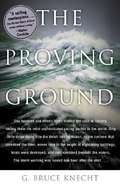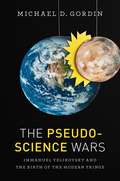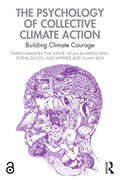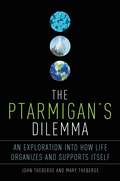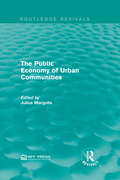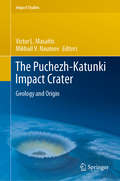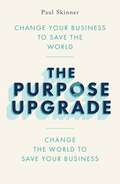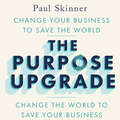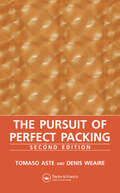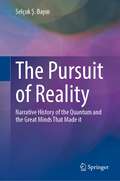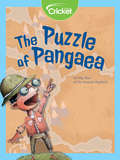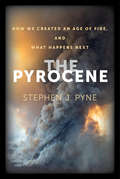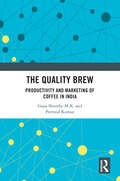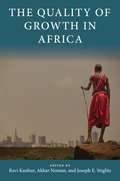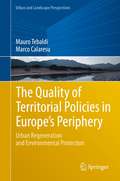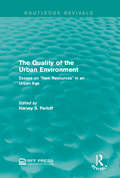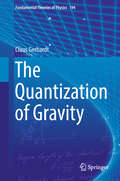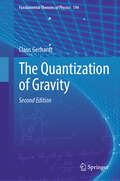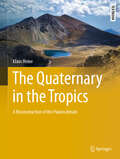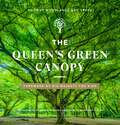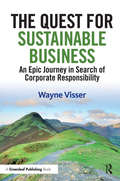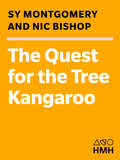- Table View
- List View
The Proving Ground: The Inside Story of the 1998 Sydney to Hobart Race
by G. Bruce KnechtThe story of one of the worst disasters in modern yachting history. 115 boats that started under clear skies in Sydney, just 43 would finish...after the fleet had been ripped apart by unforecast winds and 80-foot-high waves.
The Pseudoscience Wars: Immanuel Velikovsky and the Birth of the Modern Fringe
by Michael D. GordinProperly analyzed, the collective mythological and religious writings of humanity reveal that around 1500 BC, a comet swept perilously close to Earth, triggering widespread natural disasters and threatening the destruction of all life before settling into solar orbit as Venus, our nearest planetary neighbor. Sound implausible? Well, from 1950 until the late 1970s, a huge number of people begged to differ, as they devoured Immanuel Velikovsky’s major best-seller, Worlds in Collision, insisting that perhaps this polymathic thinker held the key to a new science and a new history. Scientists, on the other hand, assaulted Velikovsky’s book, his followers, and his press mercilessly from the get-go. In The Pseudoscience Wars, Michael D. Gordin resurrects the largely forgotten figure of Velikovsky and uses his strange career and surprisingly influential writings to explore the changing definitions of the line that separates legitimate scientific inquiry from what is deemed bunk, and to show how vital this question remains to us today. Drawing on a wealth of previously unpublished material from Velikovsky’s personal archives, Gordin presents a behind-the-scenes history of the writer’s career, from his initial burst of success through his growing influence on the counterculture, heated public battles with such luminaries as Carl Sagan, and eventual eclipse. Along the way, he offers fascinating glimpses into the histories and effects of other fringe doctrines, including creationism, Lysenkoism, parapsychology, and more—all of which have surprising connections to Velikovsky’s theories. Science today is hardly universally secure, and scientists seem themselves beset by critics, denialists, and those they label “pseudoscientists”—as seen all too clearly in battles over evolution and climate change. The Pseudoscience Wars simultaneously reveals the surprising Cold War roots of our contemporary dilemma and points readers to a different approach to drawing the line between knowledge and nonsense.
The Psychology of Collective Climate Action: Building Climate Courage
by Karen Hamann Eva Junge Paula Blumenschein Sophia Dasch Alex Wernke Julian BlehHow do we find the courage to act together against the climate crisis? This book weaves together real-life findings and examples from the socio-ecological movement with psychological research to show how motivation for collective climate action can be built.The book addresses two key questions: how can individuals be motivated to participate in collective climate action, and how can climate groups become resilient and effective? Specifically, it explores how individuals can foster their identification with climate action groups and the belief in their joint efficacy. It touches on a wide range of topics, covering anger, moral considerations, activist burnout, and the perception of protests, as well as general theories of socio-ecological change.This book is for anyone who is seeking the courage to act together and is curious about psychological insights. It will be essential reading for climate and environmental practitioners, climate activists and campaigners, climate change communicators, and anyone involved in socio-ecological change. It will also be of interest to students and researchers in the fields of environmental psychology, climate change, collective action, and political psychology.The Open Access version of this book, available at http://www.taylorfrancis.com, has been made available under a Creative Commons (CC BY) 4.0 license.
The Psychology of Pro-Environmental Communication: Beyond Standard Information Strategies
by Christian A. KlöcknerThe environment is part of everyone's life but there are difficulties in communicating complex environmental problems, such as climate change, to a lay audience. In this book Klöckner defines environmental communication, providing a comprehensive and up-to-date analysis of the issues involved in encouraging pro-environmental behaviour.
The Ptarmigan's Dilemma: An Ecological Exploration into the Mysteries of Life
by Mary Theberge John ThebergeDrawing on breakthrough research in evolution, genetics, and on their extensive work in the field and lab, wildlife biologists John and Mary Theberge explain for non-scientists the real facts of life. Birds that suddenly grow gall bladders, when their species has none. Moose with antlers so big they encumber their movement through the forest. Butterflies that risk extinction by overwintering en masse. These are just a few stories the Theberges tell in their examination of what the mechanisms of evolution are and how they work. With examples from the very latest discoveries in genetics and ones they have made in their own field work, The Ptarmigan's Dilemma is a ground-breaking explanation of evolution for non-scientists. By marrying the separate sciences of ecology and genetics, the Theberges paint a picture far richer than either discipline can alone of how, for almost 4 billion years, life on Earth has evolved into the rich diversity that's under threat today. Along the way, they explain just what "the survival of the fittest" really means, how dramatic evolutionary changes can take place in just one generation, and how our too-little knowledge of or interest in how life on Earth organizes and supports itself is rapidly making us a danger to ourselves.
The Public Economy of Urban Communities: Papers Presented At The 2nd Conference On Urban Public Expenditures, Feb. 21-22, 1964 (Routledge Revivals)
by Julius MargolisOriginally published in 1965, Margolis brings together a wide variety of papers on a multitude of subjects relating to the urban public economy presented at the second conference on urban public expenditures in 1964. This collection covers issues such as criteria for decision-making in urban public spending, public and private supply and the political and voting behaviour of urban economies in order to contribute to the development of new analytical models and techniques as well as to disseminate findings of research results to a larger audience. This title will be of interest to those studying Environmental studies and Economics as well as professionals.
The Puchezh-Katunki Impact Crater: Geology and Origin (Impact Studies)
by Victor L. Masaitis Mikhail V. NaumovThis book presents essential data on the geology of the Puchezh-Katunki crater – an early Jurassic crater located on the East European Platform, with an impact structure that is ca. 80 km in diameter. Offering a comprehensive guide, it reviews the studies carried out during the last several decades on this prominent but not well-known impact structure. It offers the international community state-of-the-art information on the crater with regard to e.g. structural mapping, drilling (including the Vorotilovo well, which is 5374 m deep), geophysical research, and the petrological analysis of impactites and various breccias. In addition, the book includes new results from the mineralization and crystallizations beneath this large impact crater, and suggests new models for crater formations.
The Purpose Upgrade: Change Your Business to Save the World. Change the World to Save Your Business
by Paul SkinnerUnlock greater profits. Empower happier and more engaged staff. Foster loyalty and connection with customers. Save your business... and the world. How? It all starts with a Purpose Upgrade.History shows that hard times can lead to the greatest opportunities for renewal. The Purpose Upgrade will support readers in leading enterprises that thrive by solving our most important problems.It shows how businesses can create more compelling benefits for customers, build meaningful livelihoods for colleagues, and unlock superior returns for investors by 'repurposing' and revitalising the activities they engage in.Meet the social entrepreneur who repurposed the previously 'boring' trade in office supplies to fund micro-finance initiatives that reach millions of the people most exposed to poverty, so that 'even a bad day at the office saves lives'.Learn how the leaders of a coal-mining business repurposed their enterprise first as an industrial chemicals company and then more spectacularly as a sustainable living business, generating unprecedented shareholder returns by aligning their objectives with the United Nations Sustainable Development Goals. They are now changing the lives of smallholder farmers, re-directing the food system to a more sustainable model, and harnessing the power of the world's biggest brands to provide more nutritious food on a healthier planet. And, most importantly, discover a unique methodology that you can use to make a Purpose Upgrade an always-available event at any level of your own enterprise.There has never been a more urgent need to change our businesses to save the world or a more opportune time to change the world to save our businesses.
The Purpose Upgrade: Change Your Business to Save the World. Change the World to Save Your Business
by Paul SkinnerUnlock greater profits. Empower happier and more engaged staff. Foster loyalty and connection with customers. Save your business... and the world. How? It all starts with a Purpose Upgrade.History shows that hard times can lead to the greatest opportunities for renewal. The Purpose Upgrade will support readers in leading enterprises that thrive by solving our most important problems.It shows how businesses can create more compelling benefits for customers, build meaningful livelihoods for colleagues, and unlock superior returns for investors by 'repurposing' and revitalising the activities they engage in.Meet the social entrepreneur who repurposed the previously 'boring' trade in office supplies to fund micro-finance initiatives that reach millions of the people most exposed to poverty, so that 'even a bad day at the office saves lives'.Learn how the leaders of a coal-mining business repurposed their enterprise first as an industrial chemicals company and then more spectacularly as a sustainable living business, generating unprecedented shareholder returns by aligning their objectives with the United Nations Sustainable Development Goals. They are now changing the lives of smallholder farmers, re-directing the food system to a more sustainable model, and harnessing the power of the world's biggest brands to provide more nutritious food on a healthier planet. And, most importantly, discover a unique methodology that you can use to make a Purpose Upgrade an always-available event at any level of your own enterprise.There has never been a more urgent need to change our businesses to save the world or a more opportune time to change the world to save our businesses.
The Purpose Upgrade: Change Your Business to Save the World. Change the World to Save Your Business
by Paul SkinnerUnlock greater profits. Empower happier and more engaged staff. Foster loyalty and connection with customers. Save your business... and the world. How? It all starts with a Purpose Upgrade.History shows that hard times can lead to the greatest opportunities for renewal. The Purpose Upgrade will support readers in leading enterprises that thrive by solving our most important problems.It shows how businesses can create more compelling benefits for customers, build meaningful livelihoods for colleagues, and unlock superior returns for investors by 'repurposing' and revitalising the activities they engage in.Meet the social entrepreneur who repurposed the previously 'boring' trade in office supplies to fund micro-finance initiatives that reach millions of the people most exposed to poverty, so that 'even a bad day at the office saves lives'.Learn how the leaders of a coal-mining business repurposed their enterprise first as an industrial chemicals company and then more spectacularly as a sustainable living business, generating unprecedented shareholder returns by aligning their objectives with the United Nations Sustainable Development Goals. They are now changing the lives of smallholder farmers, re-directing the food system to a more sustainable model, and harnessing the power of the world's biggest brands to provide more nutritious food on a healthier planet. And, most importantly, discover a unique methodology that you can use to make a Purpose Upgrade an always-available event at any level of your own enterprise.There has never been a more urgent need to change our businesses to save the world or a more opportune time to change the world to save our businesses.
The Pursuit of Perfect Packing
by Tomaso Aste Denis WeaireCoauthored by one of the creators of the most efficient space packing solution, the Weaire-Phelan structure, The Pursuit of Perfect Packing, Second Edition explores a problem of importance in physics, mathematics, chemistry, biology, and engineering: the packing of structures. Maintaining its mathematical core, this edition continues and rev
The Pursuit of Reality: Narrative History of the Quantum and the Great Minds That Made it
by Selçuk Ş. BayınIn a highly accessible style, this book presents a narrative history of the quantum theory with the new developments that intrigue all inquisitive minds. Quantum theory is counter-intuitive and sometimes downright weird. Even Nobel Laureate physicists like Richard Feynman admit that they do not understand it. Yet, so far, there is not a shred of experimental data that conflicts with its predictions. Its effect on our lives is bound to increase with the quantum information era ushered in by the great Bohr–Einstein debate. Tantalizing applications of quantum information like teleportation, spy-proof communication, super-fast quantum computers, and more are going to influence our lives and change our beliefs about the nature of physical reality. This book takes the reader on an exhilarating journey through the intellectual history of quantum that is turning out to be more surprising every day.
The Puzzle of Pangaea
by Meg MossDeep underground, unseen forces are at play to move the continents around our globe.
The Pyrocene: How We Created an Age of Fire, and What Happens Next
by Stephen J. PyneA dramatic reorientation of humanity’s relationship with fireThe Pyrocene tells the story of what happened when a fire-wielding species, humanity, met an especially fire-receptive time in Earth's history. Since terrestrial life first appeared, flames have flourished. Over the past two million years, however, one genus gained the ability to manipulate fire, swiftly remaking both itself and eventually the world. We developed small guts and big heads by cooking food; we climbed the food chain by cooking landscapes; and now we have become a geologic force by cooking the planet. Some fire uses have been direct: fire applied to convert living landscapes into hunting grounds, forage fields, farms, and pastures. Others have been indirect, through pyrotechnologies that expanded humanity's reach beyond flame's grasp. Still, preindustrial and Indigenous societies largely operated within broad ecological constraints that determined how, and when, living landscapes could be burned. These ancient relationships between humans and fire broke down when people began to burn fossil biomass—lithic landscapes—and humanity’s firepower became unbounded. Fire-catalyzed climate change globalized the impacts into a new geologic epoch. The Pleistocene yielded to the Pyrocene. Around fires, across millennia, we have told stories that explained the world and negotiated our place within it. The Pyrocene continues that tradition, describing how we have remade the Earth and how we might recover our responsibilities as keepers of the planetary flame.
The Pythagorean World
by Jane McdonnellThis book explores precisely how mathematics allows us to model and predict the behaviour of physical systems, to an amazing degree of accuracy. One of the oldest explanations for this is that, in some profound way, the structure of the world is mathematical. The ancient Pythagoreans stated that "everything is number". However, while exploring the Pythagorean method, this book chooses to add a second principle of the universe: the mind. This work defends the proposition that mind and mathematical structure are the grounds of reality.
The Quality Brew: Productivity and Marketing of Coffee in India
by Parmod Kumar Gana Shruthy M.K.Coffee is a major commodity of export in developing countries. In India, it generates significant revenues besides providing employment to many. This book critically looks into various aspects of the coffee production and marketing industry and its potential for promoting sustainable development, poverty alleviation and providing decent work.The small-holder dominated coffee sector is under unprecedented crisis attributed to a host of factors like declining productivity, incidences of new pests and diseases, adverse price trends and issues related to global warming induced climate change. Supported with primary survey and secondary data, this book explores challenges related to coffee production and its economic importance in India. It analyses factors affecting productivity of Robusta and Arabica varieties of coffee— and offers important inferences about the relationship between age and productivity of the plants and factors that guarantee high productivity. The book also sheds light on institutional interventions and the use of IT applications, along with online trading, in the coffee sector.Comprehensive and insightful, the book will be of interest to students and researchers of agriculture studies, agricultural economics, horticulture with a special focus on spices and plantation, sustainability studies, development studies and crop science. It will also be useful to stakeholders of plantation crops, such as, growers, as well as policy makers, processors, traders and exporters at different levels.
The Quality of Growth in Africa (Initiative for Policy Dialogue at Columbia: Challenges in Development and Globalization)
by Joseph E. Stiglitz Ravi Kanbur Akbar NomanIn recent years, concerns about the outcomes and nature of economic growth have given way to a new emphasis on its quality. This volume brings together prominent international contributors to consider a range of interrelated questions concerning the quality of growth in Africa, with a primary focus on sub-Saharan countries.Contributors discuss the measurement of growth, the transformations necessary to sustain it, and issues around equity and well-being. They consider topics such as the distribution of income gains from growth; the extent to which economic growth has resulted in improvements in employment, poverty, and security; structural transformations of the economy and diversification of the sources of growth; environmental sustainability; and management of urbanization. Offering both diagnoses and prescriptions, The Quality of Growth in Africa helps envision a future that goes beyond increasing GDP to ensuring that growth translates into advancements in well-being. Although the book focuses on sub-Saharan Africa, much of the contributors’ incisive analysis has implications for countries outside the region.
The Quality of Territorial Policies in Europe’s Periphery: Urban Regeneration and Environmental Protection (Urban and Landscape Perspectives #22)
by Mauro Tebaldi Marco CalaresuThis book focuses on territorial policies as instruments for local development in Europe’s periphery. Using a multiple-case research design in three typical case studies in the context of the Mediterranean island of Sardinia (Italy), we empirically test the hypothesis that the institutionalisation of the governance system is an independent variable that is capable of influencing the quality of public policy, intended as a dependent variable. According to this hypothesis, the two above-mentioned variables tend to change according to a linear and direct correlation: upward variation of the degree of institutionalisation of the governance system tends to correspond to upward variation in the quality of the policy, and vice versa. In our conclusions, we discuss the descriptive and prescriptive implications of the empirical findings of the research for the local development of peripheral areas. Regarding the descriptive implications, we explain how territorial policy-making can be articulated, based on the degree of institutionalisation of the governance system and the quality of the territorial policies. Regarding the prescriptive implications, we identify the best practices for territorial governance in order to improve the chances of local development in Europe’s periphery.
The Quality of the Urban Environment: Essays on "New Resources" in an Urban Age (Routledge Revivals)
by Harvey S. PerloffThe quality of the environment in which people live, work, and play influences to no small degree the quality of life itself. The environment can be satisfying and attractive and provide scope for individual development or it can be poisonous, irritating and stunting. The papers in this volume, first published in 1969, are concerned with the urban environment – in which the majority of Americans live – or, more accurately, with the environment of urbanites, for the concern extends to outlying areas where urban dwellers visit and play. The chapters aim to provide a better understanding of the natural resource elements in the urban environment, and will be of interest to students of environmental studies and human geography.
The Quantization of Gravity (Fundamental Theories of Physics #194)
by Claus GerhardtA unified quantum theory incorporating the four fundamental forces of nature is one of the major open problems in physics. The Standard Model combines electro-magnetism, the strong force and the weak force, but ignores gravity. The quantization of gravity is therefore a necessary first step to achieve a unified quantum theory. In this monograph a canonical quantization of gravity has been achieved by quantizing a geometric evolution equation resulting in a gravitational wave equation in a globally hyperbolic spacetime. Applying the technique of separation of variables we obtain eigenvalue problems for temporal and spatial self-adjoint operators where the temporal operator has a pure point spectrum with eigenvalues $\lambda_i$ and related eigenfunctions, while, for the spatial operator, it is possible to find corresponding eigendistributions for each of the eigenvalues $\lambda_i$, if the Cauchy hypersurface is asymptotically Euclidean or if the quantized spacetime is a black hole with a negative cosmological constant. The hyperbolic equation then has a sequence of smooth solutions which are products of temporal eigenfunctions and spatial eigendistributions. Due to this "spectral resolution" of the wave equation quantum statistics can also be applied to the quantized systems. These quantum statistical results could help to explain the nature of dark matter and dark energy.
The Quantization of Gravity (Fundamental Theories of Physics #194)
by Claus GerhardtA unified quantum theory incorporating the four fundamental forces of nature is one of the major open problems in physics. The Standard Model combines electro-magnetism, the strong force and the weak force, but ignores gravity. The quantization of gravity is therefore a necessary first step to achieve a unified quantum theory. In this monograph a canonical quantization of gravity has been achieved by quantizing a geometric evolution equation resulting in a hyperbolic equation in a fiber bundle, where the base space represents a Cauchy hypersurface of the quantized spacetime and the fibers the Riemannian metrics in the base space. The hyperbolic operator, a second order partial differential operator, acts both in the fibers as well as in the base space. In this second edition new results are presented which allow the solutions of the hyperbolic equation to be expressed as products of spatial and temporal eigenfunctions of self-adjoint operators. These eigenfunctions form complete bases in appropriate Hilbert spaces. The eigenfunctions depending on the fiber elements are a subset of the Fourier kernel of the symmetric space SL(n,R)/SO(n), where n is the dimension of the base space; they represent the elementary gravitons corresponding to the degrees of freedom in choosing the entries of Riemannian metrics with determinants equal to one. These are all the degrees of freedom available because of the coordinate system invariance: For any smooth Riemannian metric there exists an atlas such that in each chart the determinant of the metric is equal to one. In the important case n=3 the Standard Model could also be incorporated such that one can speak of a unified quantization of all four fundamental forces of nature.
The Quaternary in the Tropics: A Reconstruction of the Palaeoclimate (Springer Textbooks in Earth Sciences, Geography and Environment)
by Klaus HeineThe Ice Age (Quaternary) is a period of extreme climate fluctuations that led to the growth and melting of massive ice sheets in the high latitudes. Tropical deserts, savannas, rainforests, and mountainous regions experienced equal dramatic climatic changes of which the traces are preserved in sedimentary deposits. The knowledge of tropical climate history is of paramount importance because in the tropics and marginal tropics, natural and - more recently - human-induced processes significantly control global climate. Yet relatively few palaeoclimate records are known from these regions.This book presents the climate archives of the tropics and critically discusses their palaeoclimatic informative value. Based on decades of research the author demonstrates that a lack of geoecological knowledge leads to misinterpretations in modeling climate futures. The results presented here call for a correction of many widely held views about the role of atmospheric greenhouse gases in global warming over the past 150 years.The book is intended for natural scientists of all disciplines who are looking for a synopsis of the problem area "Our climate in the past, present and future in the tropics".
The Queen's Green Canopy: Ancient Woodlands and Trees
by Adrian Houston Charles Sainsbury-PlaiceStunning photographs of the United Kingdom's most spectacular trees - with a foreword by His Majesty the King.The Queen's Green Canopy is a beautiful photography book showcasing 70 ancient trees and 70 ancient woodlands dedicated by the QGC initiative in honour of Her Majesty's Platinum Jubilee.The book features extraordinary photographs of the United Kingdom's best-loved trees, many of which inspired historic figures, artists and writers through the centuries.Alongside these photographs are short written pieces from contributors including Dame Judi Dench, Alan Titchmarsh, Dame Joanna Lumley, Adam Henson, Archbishop Justin Welby and Danny Clarke, as well as conservation experts from the Woodland Trust and the Duchy of Cornwall. In these pieces they reflect on the trees that have made a mark on their lives and the importance of protecting Britain's woodlands for future generations.Selected trees include yews at a Cotswold's church which inspired JRR Tolkien; the apple tree believed to have inspired Sir Isaac Newton's theory of gravity; the Five Hundred Acre Wood in East Sussex immortalised in AA Milne's Winnie the Pooh books; and the 2,500-year-old tree where Henry VIII may have proposed to Anne Boleyn.So far 3 million trees have been planted by communities, schools and businesses across the country as part of the QGC initiative. Through incredible imagery and joyful pieces of writing, The Queen's Green Canopy celebrates Her Majesty's extraordinary life and the amazing legacy she leaves behind.
The Quest for Sustainable Business: An Epic Journey in Search of Corporate Responsibility
by Wayne VisserIn January 2010, author, academic and social entrepreneur Dr Wayne Visser set off on a nine-month, 20-country "quest" to talk to entrepreneurs, business leaders and innovators and learn about how companies in all parts of the world can and are helping to tackle the world's most pressing social and environmental problems. His aim was to explore the many varieties of global approaches to sustainable business practices first-hand and to share some of the most innovative global examples.The result is this treasure trove of a book, full of stories, ideas, links to more than 100 video interviews, best practices and tools for making sustainable business work in a myriad of different contexts, cultures and settings. Besides sharing insights from his 2010 "CSR Quest World Tour", the author captures his professional experiences and the evolution of sustainable business over the past 20 years.The path begins in Africa and winds its way through Asia, North America, Europe, Australasia and Latin America. The author shares what he has learned in encounters with mega-corporations and small farmers, and conversations with CEOs and social entrepreneurs. There are facts and figures about world trends, and interviews with thought leaders and activists. This is a tale that consciously weaves the personal and the professional, mixing anecdotes and case studies. It looks outwards and reflects inwards, and is both autobiography and the life story of a global movement.
The Quest for the Tree Kangaroo: An Expedition to the Cloud Forest of New Guinea (Scientists in the Field Series)
by Sy Montgomery Nic Bishop<P>It looks like a bear, but isn't one. It climbs trees as easily as a monkey- but isn't a monkey, either. It has a belly pocket like a kangaroo, but what's a kangaroo doing up a tree? Meet the amazing Matschie's tree kangaroo, who makes its home in the ancient trees of Papua New Guinea's cloud forest. And meet the amazing scientists who track these elusive animals. <P>[This text is listed as an example that meets Common Core Standards in English language arts in grades 4-5 at http://www.corestandards.org.] <P><P> Winner of the Sibert Honor
